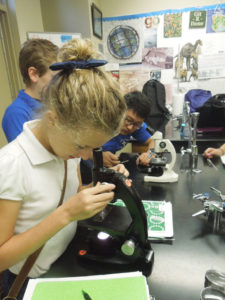By Anne Marie Amacher
The Catholic Messenger
Four priorities have been selected as part of the Catholic schools strategic plan for the Diocese of Davenport: Catholic identity, school finance and school vitality, enrollment management and vitality, and communication.
Lee Morrison, diocesan superintendent of Catholic schools, said a lot of research, studies, surveys and meetings went into preparation of the final plan that sets a vision for the next decade. He noted that as variables change, such as technology and population, the plan may need to be adjusted in the future.

Sherlynne Brown, a seventh-grader at Prince of Peace Catholic School in Clinton, looks through a microscope in science class. Her school and others in the diocese stand to benefit from a new Catholic school strategic plan.
Bishop Martin Amos said, “I think these four strategies are foundational and interrelated and follow logically from one to another. If we are not ‘Catholic’ there is no reason for our schools to exist. To exist they need to be financially sound. To be financially sound full enrollment and vitality are essential. These three need to be effectively communicated to the larger community, the parish community and the school community.” The bishop observed that much input was sought from many sources and carefully categorized and analyzed.
Catholic identity
A committee will be formed to develop Catholic identity rubrics for Catholic schools. “We offer strong academics and a good environment, but it’s important that we uphold the mission of the Catholic Church,” Morrison said. He anticipates the committee will look at ways to incorporate religion into other classes and how much time will be spent teaching religion in the classroom.
School finance and school vitality
This committee will consider tuition models, parish subsidy, cost per pupil, diocesan-wide support for Catholic education and funding sources. “We need to look at school budgets and see what other sources of revenue we can get to ease the burden for families and parishes,” Morrison said. “We want to ensure the long-term viability of our Catholic schools.”
Enrollment management
This committee will examine birth rates, baptism rates and location of Catholic schools. They will also look at growth capacity for each school, and marketing. Morrison said larger schools may have more resources to market their schools than smaller ones. He hopes this committee will help smaller schools to be able to market themselves. “We need to promote Catholic education.”
Communication
“We need to tell our story about Catholic education,” Morrison said. More communication between the Catholic schools’ office and parents has been addressed. Now he’s working on future e-mail blasts to parents and figuring out how to determine the appropriate frequency.
Although not in the top four priorities, two subgroups will address Catholic education availability in the diocese’s two most populous counties: Johnson (Iowa City area) and Scott (Bettendorf-Davenport area). These groups will examine potential growth or adjustment and emphasis on professional development to meet the changing needs of students.
Through the strategic planning process, some “controversial” topics arose that will be addressed: climate control, 1:1 ratio initiative in technology, diocesan-wide support of Catholic schools, and teacher salaries.
Most but not all of the Catholic schools have some sort of climate control, Morrison said. He urges schools to look at what it might take to make their buildings climate controlled by the end of the decade. He has also asked schools to respond to the 1:1 technology initiative. This does not mean that every student has to have a computer in every grade, Morrison said. It’s looking at “How can you enhance curriculum and staff development.”
Some U.S. dioceses offer support for Catholic education through their annual appeals while others do so through capital campaigns. “We will explore options for additional revenue,” he said.
Teacher salaries have been a topic for years. Morrison acknowledges that Catholic school teachers earn less than their public school counterparts. He and other strategic planners believe salaries should be at least 80 percent of public school teacher salaries. Surveys show that 77 percent of the Catholic school teachers who responded said they were teaching for the mission of the church. “They like the environment, faith and strong academics.”
As part of the strategic planning process more than 100 policies have been revised, such as board orientation materials, new teacher orientation, hiring of principals and interview question banks. Some changes adapt public school policies to fit within the Catholic mission.
Of the strategic plan, Morrison noted, “We can’t predict the future, but we hope to see some bold moves in the next three years.”
“Four priority goals or areas were selected for this first year,” observed Msgr. John Hyland, the diocese’s vicar general. “These are very relevant areas for the future of our Catholic schools and their importance in passing on the faith to our young people.”
He commended Morrison and Dan Ebener, diocesan director of stewardship and parish planning, for collaborating on the plan. Msgr. Hyland said: “In my 22 years in administration of a Catholic school system and as a principal, as well as a pastor with Catholic schools, this is the first strategic plan that has been developed encompassing all our Catholic schools in the diocese. I am hopeful that this process will strengthen our schools in the future.”
“One of the greatest benefits of the process is the richness of information that not only was available in writing the plan but, perhaps even more beneficial, is now available in implementing the plan,” said Chad Steimle, principal of John F. Kennedy Catholic School in Davenport. “The plan provides a good balance between school-led and diocesan-led actions. If there is to be any diocesan strategic plan for education, there will be areas that are, naturally, more diocesan-led,” he said.
“The diocese and any diocesan committees can provide the encouragement, impetus, support, framework, and guidance for many areas of the plan,” he added. “On the other hand, the plan also recognizes that implementation is, ultimately, at a local level. There are plenty of areas in the plan that state that local boards and administrators shall lead the efforts.”











